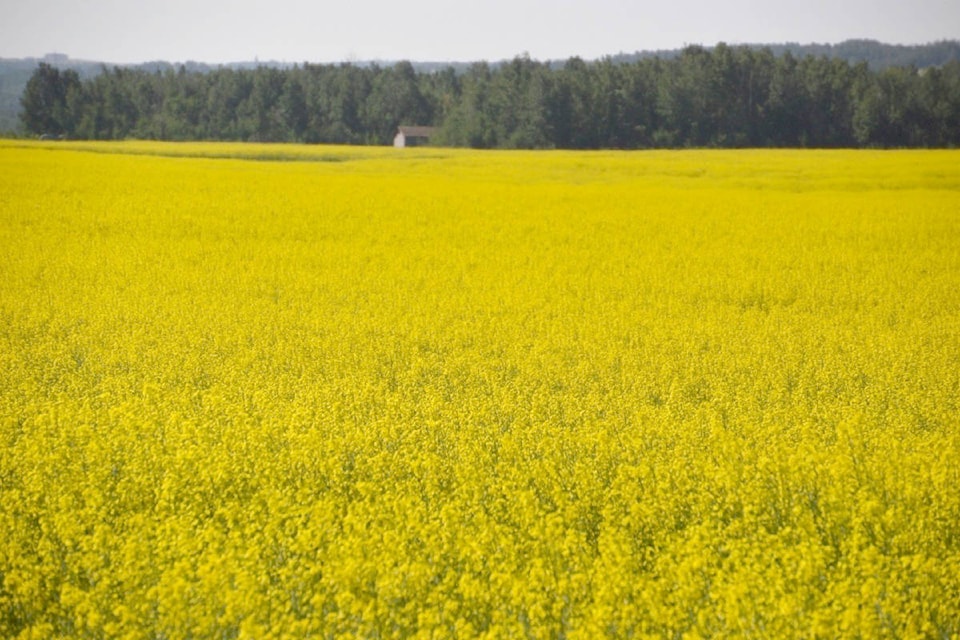“A lot of canola may be swathed, due to second growth from hail, but all canola requires more heat before harvest begins,” says Harry Brook, crop specialist at the Alberta Ag-Info Centre. “It is a good idea to review conditions needed prior to swathing or treatment prior to straight cutting.”
He says that canola should be swathed when the average seed moisture content is 30 to 35%, which corresponds to 60% of seeds having some colour change.
“Swathing decisions should be based on observations of seed colour change on the plant’s main stem if the crop is thick with few lateral branches. If the crop is a thin stand, with a lot of lateral branching and most of the pods are on the lateral, then use the colour change on the lateral branches to decide when to swath.”
“At the optimal time for swathing, seed in the middle third of the stem will have at least some colour change, the most mature seed in the bottom third of the stem will have complete colour change, and the seed in top pods will be green but firm and should not squish when rolled between fingers.”
“Assess where the majority of the yield is and use that to determine time of swathing. Keep in mind that pod colour change may be a poor indicator of maturity, so it is essential to check for seed colour change throughout the field to best estimate harvest staging.”
Under hot conditions, canola should be swathed early in the morning or later at night. The big danger in swathing canola under very warm conditions is the risk of locking in the green colour due to too rapid a dry down. Chlorophyll in the seed is one of the last things to be removed prior to seed maturity.
“It takes time for the crop to cure out and remove all green seed,” he adds. “If you swath too early or during the heat of the day, the curing process can occur too rapidly and the enzyme may not have enough time to remove all chlorophyll. The enzyme that clears the green colour out is most active at temperatures above 15 C. Seed moisture content must be at 20% or more. The warmer the temperature, the more active the enzyme will be and the quicker the colour will be cleared.”
Brook says that another cause of green seed is from an untimely frost, which could be a real risk for late seeded crops this year.
“When immature canola - either standing or freshly swathed - is hit with sustained cold temperatures below zero, ice crystals form in the plant cells and break the walls, letting the cell liquid leak out. Like a too-rapid dry down, this can lock in the green colour. The only way this can be removed is if the seed is rewetted and temperatures are warm enough to reactivate the enzyme. To prevent green seeds in canola, the crop should be swathed at least three days before the killing frost, allowing the crop to dry where it will not be affected by the cold.”
Harvesting the crop is not the end of the story, and Brook says that the temperature of the crop at harvest is very important, too.
“Safe storage of any crop is a combination of the temperature of the crop entering the bin and the moisture level of the crop. There have been producers who have binned their canola at 10% moisture, assuming it was dry, and a couple months later they find a bin of heated canola. Under hot or warm conditions, once the crop is in the bin there is a circulation of moisture from the sides, down to the bottom and then up through the middle. If there is any moisture accumulation or heating occurring in the bin in the fall, it will be near the top to the middle of the bin.”
If the crop is coming into the bin hot with temperatures above 25 C, he adds that it is essential to cool it as soon as possible.
“Using an aeration bin is the easiest way to do it. Those without aeration will have to move the grain to cool it. Do not confuse aeration with grain drying. Aeration requires fans to move 0.75 to 1.0 cu.ft. per minute per bushel. Cooling requires fans to move air at a fraction of that, 0.1 to 0.25 cu. ft. per minute per bushel.”
“Regardless of the method, with the big investment to get the crop seeded and harvested, it is only common sense to spend the necessary resources to ensure your valuable crop makes it to the market in good condition, as good as it was when it entered the bin,” concludes Brook.
“Using temperature sensors in the bin is another good way to monitor the canola condition. Even a metal rod shoved into the bin can be used for a sensor to indicate the condition of the crop.”
-Alberta Agri-news
